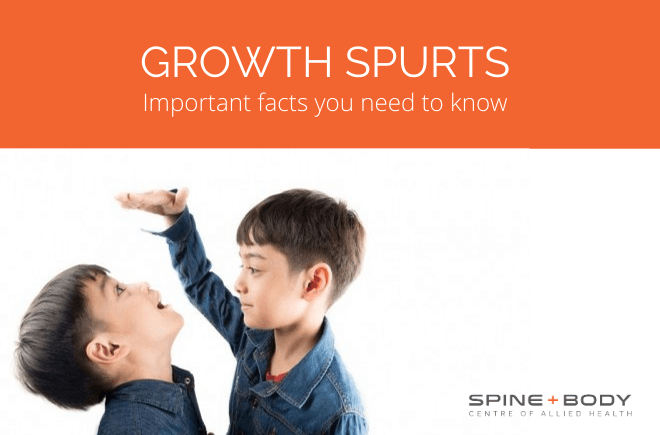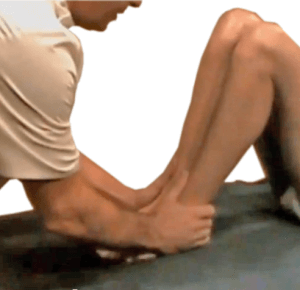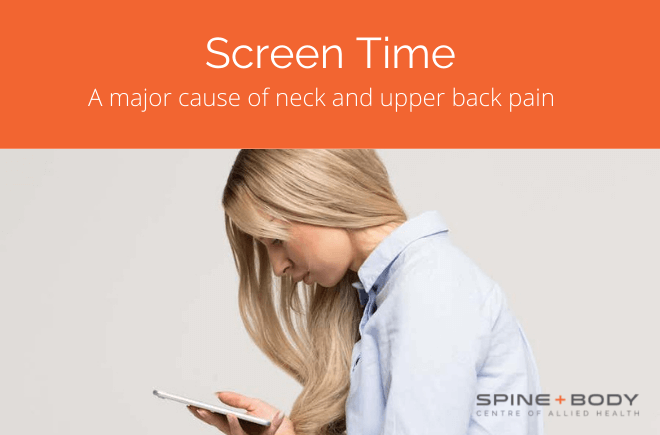Growth spurts – Important facts you need to know

By Peter Georgilopoulos, APA Sports Physiotherapist, Spine + Body Gold Coast.
It is commonly understood that the formative years are characterised by periods of rapid growth followed by periods of little or no growth.
It rarely happens that growth occurs at a steady rate and no two children are alike in predicting when growth is likely to occur and how much growth to expect at each event even amongst twins.
What is noted anecdotally (but not yet investigated in research)is that in children who are highly active such as those training daily for elite teams, growth spurts often occur following periods of rest whether this be a scheduled time away from training or enforced by injury.
It may well be that the energy requirements of a young body coping with the rigors of intense and prolonged exercise funnel calories towards that activity at hand with little left over for growth.
It may also be that constant impact trauma on growth plates by running and jumping or excessive loading may temporarily retard the activity of these growth centres.
What we do know for sure is that growth can only occur at a growth plate (or epiphysis) which on long bones exists on either end of the bone (but not on both).
Any trauma injury or disruption to this growth plate can halt growth temporarily or even permanently creating a situation in which full skeletal growth potential may not eventuate. This can cause considerable problems for the child in that one limb may continue to grow leading to impaired weight bearing in many joints with the risk of early degenerative changes in later life, muscular, tendon or capsular overuse (tendonitis or bursitis) and, of course, impaired movement with implications for athletic performance.

Asymmetrical growth may not only occur between limbs resulting in one leg or arm being longer that the other, but may also occur within the bones of the same limb notably in the forearm or foreleg in which there are two bones.
This is occasionally seen in growing gymnasts presenting with acute wrist pain in which the radius (one of the long bones of the forearm) grows whilst the adjacent bone (the ulna) displays retarded growth leading to uneven weight bearing through the wrist when performing handstands or other weight bearing activities.
What is important to note is that this can also occur in the absence of any specific or identifiable trauma as well, and often rectifies itself within the next three months or so as growth in the affected bone catches up. It is important not to continue to load a joint that has undergone asymmetrical growth as the forces transmitted through the joint can have significant traumatic results.
Remember that in the majority of cases, with the avoidance of continued joint impact, injury can be prevented and the limb growth will be restored within a relatively short period.
Decline in performance and coordination
As a parent or coach of a child performing or training at an elite level, it is important to regularly check and document height gains to monitor growth spurts. It is not unusual for athletic children to become frustrated at “unexplained” performance deterioration during or immediately following a growth spurt.
The simple explanation is of course that the increased limb length and body size will play havoc with motor coordination and fluency of movement.
Adjusting to a marginally longer leg and arm length will require some degree of re-learning of a particular skill especially when fine motor performance is required such as dribbling a basketball or soccer ball or clearing a hurdle.
A common scenario facing young athletes that experience a decline in performance due to sudden growth is to train harder. Their coaches may occasionally misinterpret a recent drop in performance with a lack of motivation and may also push the athlete harder to regain previous skills.
The preferred approach when faced with this mechanical issue is to:
- Identify that growth has recently occurred
- Explain that performance fluctuations can be experienced as a normal by product of growth
- Simplify skills to a more fundamental level and be clear that this is not a “punishment” for poor performance but a means to improved performance
- Explain to the athlete that retaining correct form even at a lower level is fundamental to progressing beyond previous standards once the benefits of a taller and stronger body is incorporated into efficient movement.
What can you do?
The constantly fluctuating mechanical changes related to growth spurts need to be identified regularly and appropriate intervention undertaken. This may be as simple as applying a soft foam inner sole to a “shorter” limb for a short period of time, altering training to allow for asymmetry in weight bearing joints or simplifying previously mastered skill drills.
Quarterly screening has been a long held policy of the Australian Sports Commission sponsored athletes and teams in which both musculoskeletal and physiological reports are generated and compared with previous individual results as well as team group results.
Screening is a time efficient method of identifying potential (or actual) problems which are likely to impact on a growing athletics performance.
Spine and Body are experts in identifying and correcting bio mechanical issues. Book now to consult with one of our physiotherapists.




